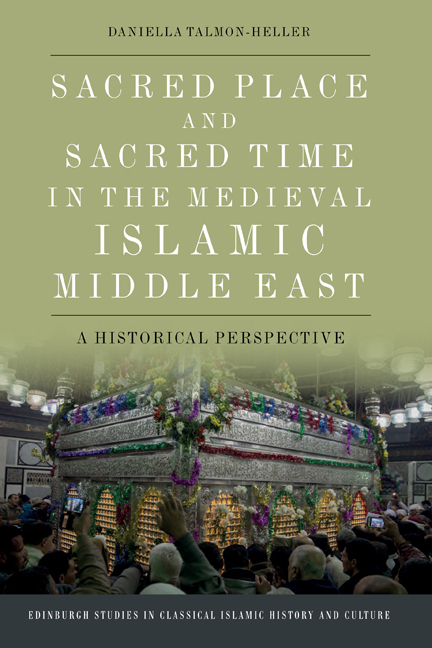Book contents
- Frontmatter
- Contents
- List of Figures
- Acknowledgements
- Map of the Middle East
- Introduction
- 1 Etic Concepts and Emic Terms
- 2 The State of the Art
- Part One A Sacred Place: The Shrine of al-Husayn’s Head
- Part Two A Sacred Time: The Month of Rajab
- Final Comments: Spacial and Temporal Sanctity
- Works Cited
- Index
11 - Excursus: al-Husayn and Saladin in Palestinian Lore
Published online by Cambridge University Press: 17 October 2020
- Frontmatter
- Contents
- List of Figures
- Acknowledgements
- Map of the Middle East
- Introduction
- 1 Etic Concepts and Emic Terms
- 2 The State of the Art
- Part One A Sacred Place: The Shrine of al-Husayn’s Head
- Part Two A Sacred Time: The Month of Rajab
- Final Comments: Spacial and Temporal Sanctity
- Works Cited
- Index
Summary
Twentieth-century Palestinian historians and publicists attribute to Saladin not only the liberation of Muslim land from the yoke of the Shiʿi Fatimids and the Christian Crusaders, as well as the return of its mosques and pulpits to their true purpose, but also the establishment of rites which would protect its borders against further intrusions. Despite an apparent lack of evidence grounded in medieval texts, Palestinian histories and ethnographies – such as those written by ʿUmar Salih al-Barghuthi and Khalid Tutakh (1923), ʿArif al-ʿArif (1943), Mahmud Saliha (1999) and Salim Tamari (2009) – either surmise, or proclaim as historical fact, that Saladin was the founder of at least five (and up to ten) shrines in the territory he had liberated. He is also considered the architect of their attendant annual festivals (mawāsim). By rendering strategic locations into pilgrimage destinations, so these writers posit, Saladin rallied enthusiastic young men to these vulnerable places, especially around Eastertime, for the sake of deterring Christian pilgrims from harassing Muslims and, if necessary, resorting to jihad. The visitation of Maqam al-Husayn and Wadi al-Naml over the course of a two-and-a-half-days-long mawsim in mid-April, on the last Thursday of the Greek-Orthodox Lent, is sometimes listed among those festivals. Fixing the date of the mawsim according to the Christian rather than the hijri calendar was typical of such popular celebration, as it ensured its recurrence in the same season every year.
In the 1930s and 1940s the mawāsim evolved into hotbeds of Palestinian patriotism and nationalism. At that time, the festival would begin on a Wednesday, with the imam of the Friday mosque of the near-by town of Majdal raising a banner in honour of al-Husayn. He led the way to Maqam al-Husayn, sitting atop a horse, followed by a long procession of men, women and children in their best clothes. They were accompanied by members of Sufi orders and derwishes, musicians and marching scouts. At some point they all gathered around the maqām to listen to sermons delivered by preachers assembled from other parts of Palestine; to participate in Sufi dhikr and dance dabka; sing and recite patriotic tunes, love lyrics and local folk songs; chant anti-British and anti-Zionist slogans; and cheer politicians who repeatedly glorified Saladin for the liberation of the land. The flag of ‘Arab Palestine’ was hoisted next to the banner of ‘Sayyidna Husayn’.
- Type
- Chapter
- Information
- Sacred Place and Sacred Time in the Medieval Islamic Middle EastA Historical Perspective, pp. 97 - 100Publisher: Edinburgh University PressPrint publication year: 2020



